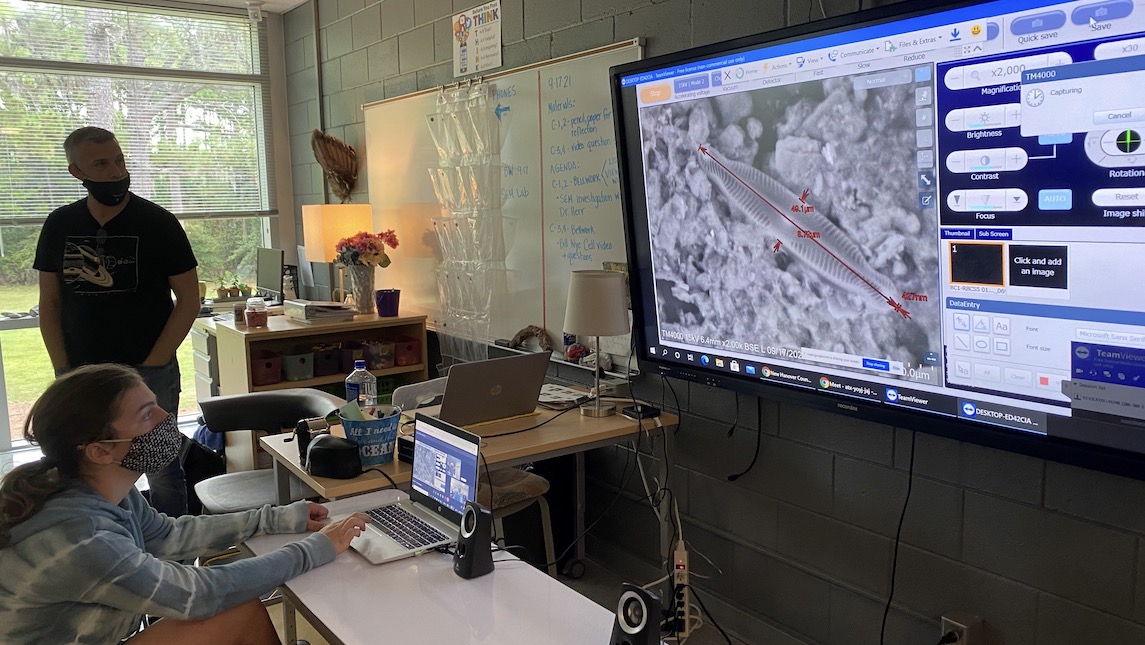Imagine a kind of sand that pulls oil out of water, helping clean up oil spills. Teeny particles that sweep through the body targeting cancer cells. Or computers that consume a fraction of the energy they once did. Some sixth, seventh, and eighth graders in North Carolina and Georgia can, thanks in part to a university outreach program that’s helping teachers make nanoscience and nanotechnology more relatable to their lives.
NanoSIMST — short for Nanoscience Summer Institute for Middle School Teachers — is a five-day program held in North Carolina and in Georgia in alternating years. The Joint School of Nanoscience and Nanoengineering (JSNN), a partnership of UNC Greensboro and North Carolina A&T State University, works with Georgia Tech to offer NanoSIMST.
In 2023, fifteen North Carolina teachers took part in the program at the JSNN in Greensboro.
Big Partnership for Study of Tiny Things
JSNN Professor Daniel Herr says the program is designed to provide participants with nanoscience knowledge, lessons, and hands-on activities to bring back into their classrooms.
NanoSIMST is part of the Southeastern Nanotechnology Infrastructure Corridor, a JSNN-Georgia Tech enterprise. As SENIC’s outreach director, Dr. Herr has helped coordinate the program with colleagues at Georgia Tech.
He says the program plants seeds for the kind of transdisciplinary education needed to advance a field in which the disciplines in science and engineering are converging to solve problems from food security and climate change to human health.
During NanoSIMST, participants gain a broad understanding of nanoscience — the study of structures and molecules down to 1 nanometer, or one billionth of a meter. While in Greensboro, this year’s participants toured JSNN facilities, heard from faculty and students, and explored ethical implications of the technology. They each wrote a lesson plan to use in their classroom, and they were trained to use an electron scanning microscope.
“One of the things we do on the electron scanning microscope is to encourage teachers to bring in samples of interest to them,” Herr says. “It stimulates questions. Looking at things in the nanoworld informs us of how we might design things in the macroworld.
“It’s one thing to look at a feather,” he explains. “It’s another thing to zoom in on the structure and see how it’s held together. It may inform how we design bridges, for example.”


Inspiring the Scientists of Tomorrow
While the advanced microscope loaned by Hitachi is important to the teachers’ NanoSIMST experience, most materials that the teachers use in the program are decidedly less high-tech and more readily available.
For example, participants mix silicon-covered sand, water, and oil to explore properties of oil and water and how those properties can be manipulated to clean up oil spills. The lab demonstrates forces at play when the three materials come into contact. When teachers bring the lab back to their classrooms, they can engage students in ways that will help prepare them for more advanced scientific exploration.
As Herr notes, “Students who’ve had hands-on (experiences) tend to have good critical thinking skills, they know their way around the laboratory a lot better, and they generally have a better time going through their degree programs.”
Nanoscience: More Than Antman
Robin Knight, an eighth-grade science teacher at Penn-Griffin School for the Arts near High Point, sees tremendous value in passing along what she learned at NanoSIMST to her students. She plans to incorporate nanoscience this year as she teaches her students about water, microbiology, chemistry, and the periodic table of elements.
“What I got out of this is how to take this really scary-sounding branch of science and turn it into something that my kids can understand,” she says. “I needed that first for myself before I could do that for my kids.”
As for her students, Knight hopes they can see a place for themselves in sciences.
“Hopefully, when they walk out of my classroom at the end of that class period or the end of that lab or the end of that lesson, they are going to say, ‘Nanoscience isn’t just Antman in a magic suit. Nanoscience can be programming a tiny little chip put in a tiny little robot that goes inside my body to find unhealthy cells.’
“And I want them to see that they can be part of the industry behind such innovation.”
Story by Dee Shore, AMBCopy, LLC
Photography provided by Dr. Daniel Herr, The Joint School of Nanoscience and Nanoengineering

Explore the Nanoworld with JSNN



